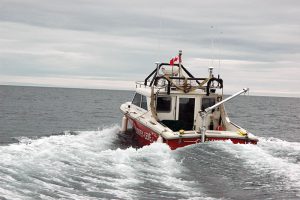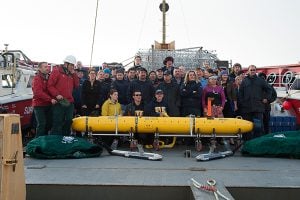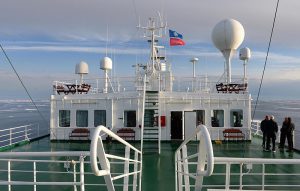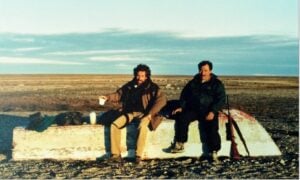
History
2014 Victoria Strait Expedition
This year's search is about much more than underwater archaeology. The Victoria Strait Expedition will contribute to northern science and communities.
- 1205 words
- 5 minutes
This article is over 5 years old and may contain outdated information.
History

For the first time this year, Parks Canada’s early Franklin expedition team is approaching the southern search area in the Queen Maud Gulf. A rolling Arctic Ocean looks exactly as you’d expect it to, a steely grey dominating both water and sky. Icebergs bob to the north, and a small but hopeful patch of blue on the southern horizon hints that the weather is more pleasant somewhere else.
Wind out of the northwest has stirred the sea into swells that splash several metres high onto the bow of the ship. The research vessel Martin Bergmann can maintain a speed of only eight kilometres per hour, but it moves methodically toward its target.
Conditions could improve by the time the Bergmann reaches the search area, but waters like these are not ideal for Parks Canada’s underwater archaeological team. Their side-scan sonar unit works best in calm conditions.
“Rough waters will smear the image we receive back from the sonar,” says Parks Canada archaeologist Jonathan Moore, pointing toward a screen with a colourful set of contours that vaguely resemble a child’s finger painting and reveal almost nothing about what they represent. “It won’t be clear, and that makes it easy to miss something that’s below. As the boat pitches up and down on the waves, it tugs on the sonar unit that is towed behind the boat. As it does, the image is distorted.”
The team’s autonomous underwater vehicle is somewhat better suited to operation in rough waters, but its use in a rough Arctic Ocean isn’t without its own set of challenges.
“The AUV’s operation is relatively unaffected by rough seas and strong currents,” Moore says. “It dealt well with the strong currents of the St. Lawrence at the wreck of the Empress of Ireland, but getting it into and out of the water is the major challenge. Even if it can do its work, we have to be able to launch it and retrieve it.”
Are you passionate about Canadian geography?
You can support Canadian Geographic in 3 ways:

History
This year's search is about much more than underwater archaeology. The Victoria Strait Expedition will contribute to northern science and communities.

History
Why this summer’s search for the lost ships of the Franklin Expedition will be the biggest and most advanced ever

History
First official day of the 2014 search for Sir John Franklin’s lost ships

History
Arctic historian Ken McGoogan takes an in-depth, contemporary perspective on the legacy of Sir John Franklin, offering a new explanation of the famous Northern mystery